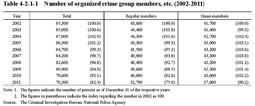Chapter 2 Offenders who Belonged to Organized Crime Groups
Section 1 Trends with Organized Crime Group Members
Table 4-2-1-1 shows the number of organized crime group members, etc. (refers to regular members and quasi-members of organized crime groups; hereinafter the same in this chapter and Chapter 3) over the last 10 years. In 2011, the number of regular members decreased by approximately 25% from that of 2002, while the number of quasi-members decreased by approximately 10%.
Table 4-2-1-1 Number of organized crime group members, etc. (2002-2011)
As of the end of 2011, 22 groups were identified as being designated organized crime groups under the Act on Prevention of Unjust Acts by Organized Crime Group Members (Act No. 77 of 1991; hereinafter referred to as the “Anti-Organized Crime Group Act”), with the number of regular members of the three major groups, namely, the Sixth Generation Yamaguchi-Gumi, the Inagawa-Kai, and the Sumiyoshi-Kai, totaling approximately 24,800 persons (down approximately 2,900 from the end of the previous year), and accounting for approximately 76% of all regular organized crime group members (Source: The Criminal Investigation Bureau, National Police Agency).
2,064 termination orders (down 66 from the previous year) and 93 recurrence preventive orders (up eight (id.)) were issued under the Anti-Organized Crime Group Act in 2011 (Source: The Criminal Investigation Bureau, National Police Agency). In addition, ordinances on eliminating organized crime groups had been established/enforced in all prefectures by 2011 and measures to eliminate organized crime groups promoted/strengthened in various areas.
